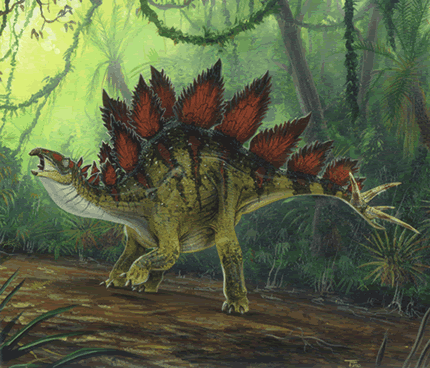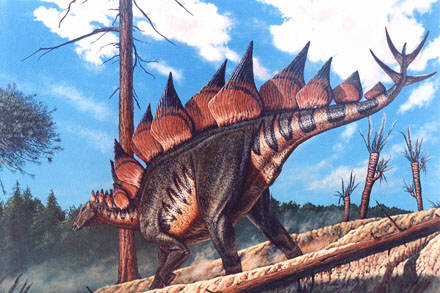Stegosaurus armatus - Ornithischian Dinosaurs
Homepage > Ornithischian Dinosaurs - Stegosaurus armatus
(steg-o-sor-uhss)
"roof plated lizard"
Describer Marsh, 1877
Also Known As --
Type of Species armatus
Order Ornithischia
SubOrder Thyreophora
InfraOrder Stegosauria
Micro-Order --
SuperFamily --
Family Stegosauridae
SubFamily --
Size 30 feet (9 meters) long
Period Late Jurassic, 156 million years ago
Fossilsite Colorado, Utah, Wyoming, USA
Diet herbivore
Stegosaurus lived during the Late Jurassic Period 156 million years ago in what is now North America. Stegosaurus was the first of the plate-backed dinosaurs to be discovered, and it is the largest dinosaur in the Stegosauridae family.
For such a large animal, it had a small brain, it was the size of a walnut. Stegosaurus had a toothless bill at the front of its mouth and weak, small teeth in its cheeks. It probably had difficulty adapting to eating a variety of different plant foods. Because of this difficulty, Stegosaurus may have swallowed gastroliths to aid the dinosaur in the digestion of this plant material.
Stegosaurus' rear legs were twice as long as its front legs. Researchers believe that Stegosaurus may have been able to stand on its hind legs to reach food in lower branches. Its bony plates along its back may have been flat, arranged in pairs. It had four large spikes on its tail that were used for protection against other predators.

Image courtesy of Todd Marshall
Stegosaurus was a slow moving dinosaur. It did not have the ability to run away from predators fast enough to avoid an attack. Because of this, its best weapon was its muscular tail, which it was armed with bony spikes at the end. Some species had a pair of these spikes and other had four pairs. The combination of a powerful, muscular tail and this large bony spikes would have delivered a possibly lethal blow to its adversary.
Stegosaurus' back plates may have protected the dinosaur against an attack. Having this plates rising from its back, may have made it awkward for animals to attack it, since large dinosaurs usually deliver an attack from the top. These plates got on the way, making it difficult for the predator to bite on vital areas of the dinosaur. While these plates may have caused confusion for the predator, the predator still had to watch out for the swinging, spiky tail.
Other theories about Stegosaurus' back plates suggest that the dinosaur used these for body temperature regulation. They may have been packed with capillary vessels close to the surface. They may have absorbed heat from the sun. If it got to hot, Stegosaurus had to go into the shade to cool down.
Discovery
Stegosaurus was discovered in 1877 by Professor Othniel C. Marsh. When
the dinosaur was discovered, and its large back plates were revealed,
they reminded the Professor of roof tiles. This is how Stegosaurus got
its name, which means "roofed lizard". Some of these plates
are 3 feet (1 meter) high. But no one is for certain how they may have
been positioned on the animal, or what they may have been used for.

Image courtesy of Michael Screpnick